|
CROWN
COLONY OF THE GOLD COAST • REPUBLIC OF GHANA |
|
The Crown Colony of the Gold Coast became the first British West African
colony to achieve independence, in 1957. Like other European
colonies on Africa's Atlantic coast, it originated as a group of
European trading enclaves, variously Portuguese, Dutch, Swedish,
Danish and English. The discovery of gold gave the territory its
name, and it was also considered part of the Slave Coast, the region
along the Bight of Benin from which most African slaves were
acquired and transported to the Americas. By the middle of the
nineteenth century the Gold Coast and its hinterland had come under
British sovereignty and were consolidated as a crown colony.
The colonial ensigns of Britain's small West African colonies all
used the same badge: an elephant and palm tree against a background
of sky and hills, differenced only by the initials of the colony.
The colonial government ensign was a British Blue Ensign with the
colony's badge in the fly. The new nation of Ghana
adopted a national flag striped horizontally in the Pan-African
colors: red, yellow and green. These colors were taken from the flag
of Ethiopia, the only country on the African continent that had
successfully resisted European colonization. The large black star on the yellow
stripe signified Ghana's status as the first colony in
West Africa to become an independent nation. Civil and naval ensigns on the British pattern were also
introduced. In 1964 the leader of the independence movement and
Ghana's first president, Kwame Nkrumah, abolished the constitution
and set up a one-party state. The yellow stripe of the Ghanaian flag
was changed to white—red, white and green were the colors of
Nkrumah's Convention People's Party. But dissatisfaction with his
increasingly despotic rule led a coup in 1966. Nkrumah was consigned
to exile and the 1957 flag was restored. |
|
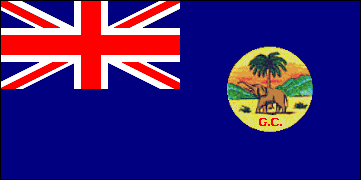
Colonial Government Ensign |
|
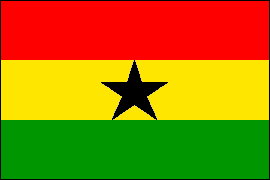
National Flag
• 1957-64 & Since 1966 |
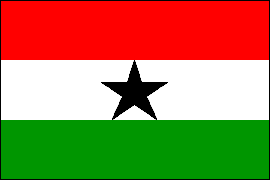
National Flag
• 1964-66 |
|
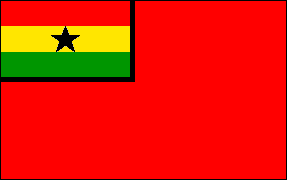
Civil Ensign
• 1957-64 & Since 1966 |
|
COLONY & PROTECTORATE OF
NIGERIA • FEDERAL REPUBLIC OF NIGERIA |
|
As the largest and
wealthiest of Britain's West African colonies, Nigeria was
expected to be the first of them to be granted independence,
though in the event this did not happen until 1960, three years
after the Gold Coast achieved independence as Ghana. Originally
Nigeria consisted of various colonies and protectorates; these
were amalgamated in 1914 to form the Colony and Protectorate of
Nigeria. Lagos Colony on the coast, which was centered around
the port city of the same name, originally had a Blue Ensign of
the standard West African pattern. When the united colony was
created, it received a new badge: an interlaced green star
called the Seal of Solomon, a symbol of Islam that also figures
in the heraldry and vexillology of Morocco. The star was given a
red background and within it was placed a British imperial crown
over the inscription NIGERIA—this last a rather useless addition
since when placed on a flag it was impossible to discern from a
distance. Nigeria also was granted a Red Ensign defaced with the
new badge to be
flown by private and commercial ships registered in the
protectorate portion of the colony. (Those registered in the
colony proper flew the undefaced Red Ensign.)
The chief executive, titled Governor-General, flew a flag of the
standard pattern for British colonial governors: the Union Jack
defaced with the colonial badge within a laurel wreath.
The national flag of independent Nigeria was chosen in 1959 after a
national competition that attracted more than 2,800 entries. The
green strips stand for fertility and agriculture; the white stripe
denotes peace and unity. Originally Nigeria followed British
practice and there were five versions of this flag: the plain
national flag as shown below, a variant for official use on land
with the state coat of arms on the white stripe, a naval ensign with
a white field, a red cross and the national flag as a canton, a
government ensign with a blue field and the national flag as a
canton, and a civil ensign with a red field and the national flag as
a canton. The state flag remains in use, the design of the naval
ensign has been changed, and the other two ensigns have probably
been abandoned. Between 1960 and 1963 Nigeria was a Commonwealth
realm with Queen Elizabeth II as head of state. The monarch was
represented in Nigeria by a Governor-General, whose flag was of the
standard pattern for such posts: blue with the Royal Crest over a
scroll inscribed with the country's name. |
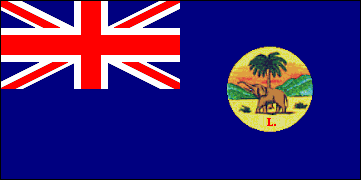
Lagos Colony • 1862-1906 |
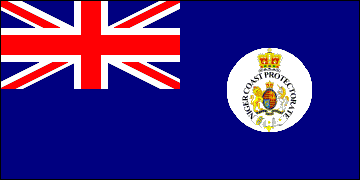
Niger Coast Protectorate • 1893-1900 |
|
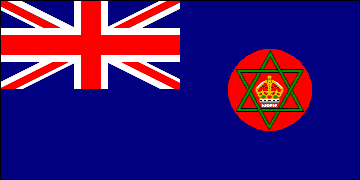
Colony & Protectorate of Nigeria
Government Ensign
• 1914-60 |
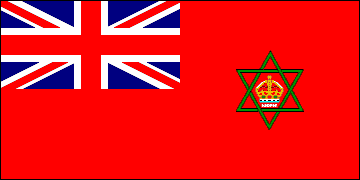
Colony & Protectorate of Nigeria
Civil Ensign
• 1914-60 |
|
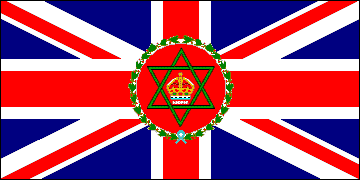
Colony &
Protectorate of Nigeria
Governor-General's Flag • 1914-60 |
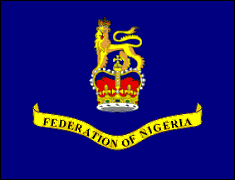
Federation of
Nigeria
Governor-General's Flag
• 1960-63 |
|
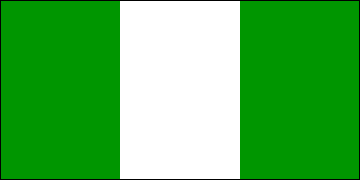
Federal Republic of Nigeria
• National Flag Since 1960 |
|
COLONY & PROTECTORATE OF
SIERRA LEONE • REPUBLIC OF SIERRA LEONE |
|
Like the neighboring Republic of
Liberia, Sierra Leone originated as a refuge for freed American
slaves. In its case the freedmen were so-called Black Loyalists,
slaves who had sided with the British during the Revolutionary War
and were emancipated by the Crown.
Prominent among them were the Nova Scotian Settlers, former slaves
whom the British had resettled in Nova Scotia. Failing to prosper
there, party due to the harsh climate and partly because of white
racism, the Settlers were transported to Sierra Leone. It was they
who built Freetown, the port that eventually became the colonial
capital. After the abolition of the slave trade in 1807, thousands
of former slaves from different parts of Africa were liberated in
Sierra Leone. In the course of the nineteenth century thousands more
arrived, particularly from the West Indies. Eventually this mixed
population gave rise to a new ethnic group, the Krio people.
In its early years the colony was run
by a private corporation, the Sierra Leone Company. Later the
British government took control and in 1924 the Colony and
Protectorate of Sierra Leone was proclaimed. For most of the
nineteenth century the governor of the British West African colonies
(excluding Nigeria) was resident in Freetown. Independence came in
1961 and until 1970 Sierra Leone was a Commonwealth realm with Queen
Elizabeth has head of state. In 1971 the country transformed itself
into a republic.
The colonial flags of Sierra Leone
were of the standard pattern. The flag adopted upon independence has
horizontal stripes of green, white and blue. Green is said to
symbolize the country’s forest-covered mountains; white and blue the
waters and wave of the sea. |
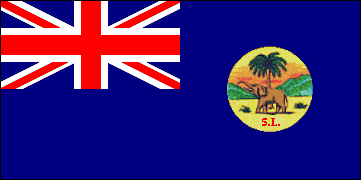
Colonial Government
Ensign • 1862-1914 |
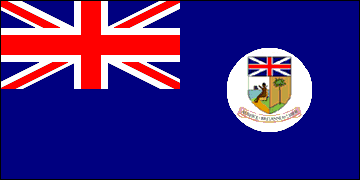
Colonial Government
Ensign
• 1914-61 |
|
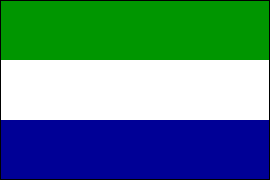
National Flag Since 1961 |
|
CROWN COLONY OF
BRITISH GAMBIA • REPUBLIC OF THE GAMBIA |
|
British Gambia was
much the smallest of the British West African colonies: an
enclave following the course of the Gambia River 200 miles
inland from its mouth on the Atlantic Ocean. Except on the
coast, the country is completely surrounded by Senegal and at its
widest point The Gambia stretches only 30 miles from north to
south. These peculiar borders are the result of agreements
between Britain and France in the colonial era. The colony
gained independence in 1965, initially as a Commonwealth realm
with Queen Elizabeth II as head of state. A republic was
proclaimed in 1970 and in 2013 The Gambia decided to leave the
"neo-colonialist" Commonwealth of Nations. The national flag
adopted in 1965 reflects the country's geography, with its
central blue stripe representing the Gambia River. Red stands
for the sun, green for fertility and agriculture, and white for
peace and unity. |
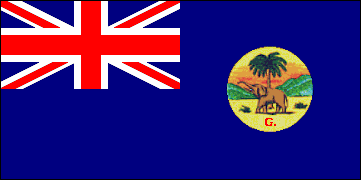
Colonial Government Ensign
|
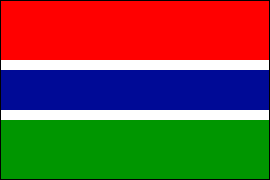
National Flag Since
1965
|















